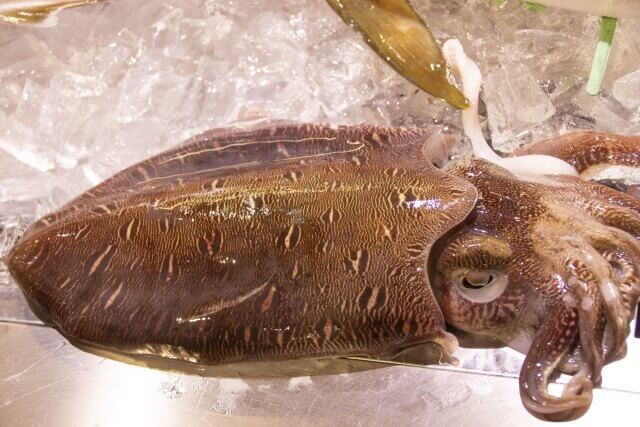
There are about 100 species of squid that live in the waters surrounding Japan. Surume ika (Japanese common squid) makes up the highest volume of domestic-caught squid. It is used as a Yari ika or Surume ika topping in eastern Japan, but Surume ika isn’t used very often in western Japan. At sushi restaurants, squid like Sumi ika (Golden cuttlefish), Aori ika (Bigfin reef squid), Kensaki ika (Swordtip squid) and Mongou ika (Ocellated cuttlefish) go for high prices, but they are all caught in smaller quantities and therefore only available to high-end sushi restaurants that can procure them fresh.
There are some conveyor belt sushi restaurants that list Mongou ika (モンゴウイカ又はカミナリイカ) on the menu, but actually serve European common cuttlefish (ヨーロッパコウイカ). It is produced in the waters off the coast of West Africa. Even some sushi restaurants do this. This is actually still too pricey for conveyor belt sushi though. What is generally used at conveyor belt sushi is Flying squid (アカイカ), which goes for only 1/10 the price of the European common cuttlefish and reaches 60 cm in length. Jumbo flying squid (アメリカオオアカイカ) is also often used. The Jumbo flying squid is more than twice as long as the Flying squid and exceeds 1 meter in length. The Jumbo flying squid is mainly imported from places on the other side of the world such as Chile and Mexico. The thickness of the meat is similar to Mongou ika. However, a big drawback is that the Jumbo flying squid lacks the sweetness peculiar to squid. Therefore, it is soaked in water that has been artificially sweetened. This alters the dried out sensation to a plump, moist sensation, making the customer believe it is Mongou ika.
The squid must have a certain thickness in order to masquerade as Mongou ika. Rhomboid squid (ソデイカ), which has a torso length of 80 cm is also disguised as Mongou ika. Rhomboid squid is found in the warm waters of the world and is even caught in relatively high volume in Japan. Large squid have a low price cost, so it’s good for the shops to make a profit. Furthermore, the sweetness is brought out more when frozen first than by serving it fresh. That means it can be used as Mongou ika without any need for the artificial sweeteners used in Flying squid and Jumbo flying squid.
The fact is that there are many substitute products for Mongou ika. But even so, it doesn’t change the fact that using ingredients disguised as others is an unacceptable practice.
We hope this information will be helpful.
Revision date: March 1, 2022
